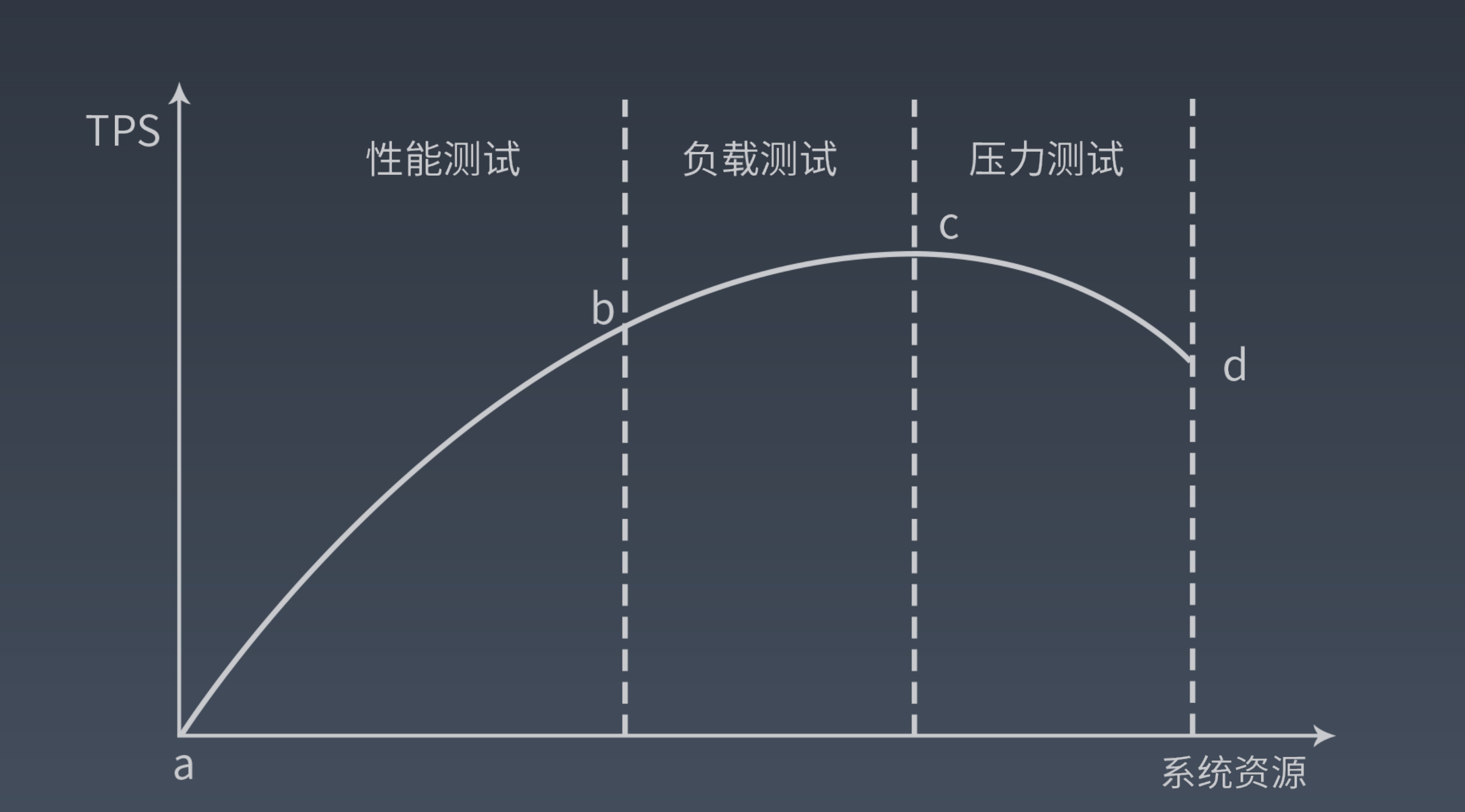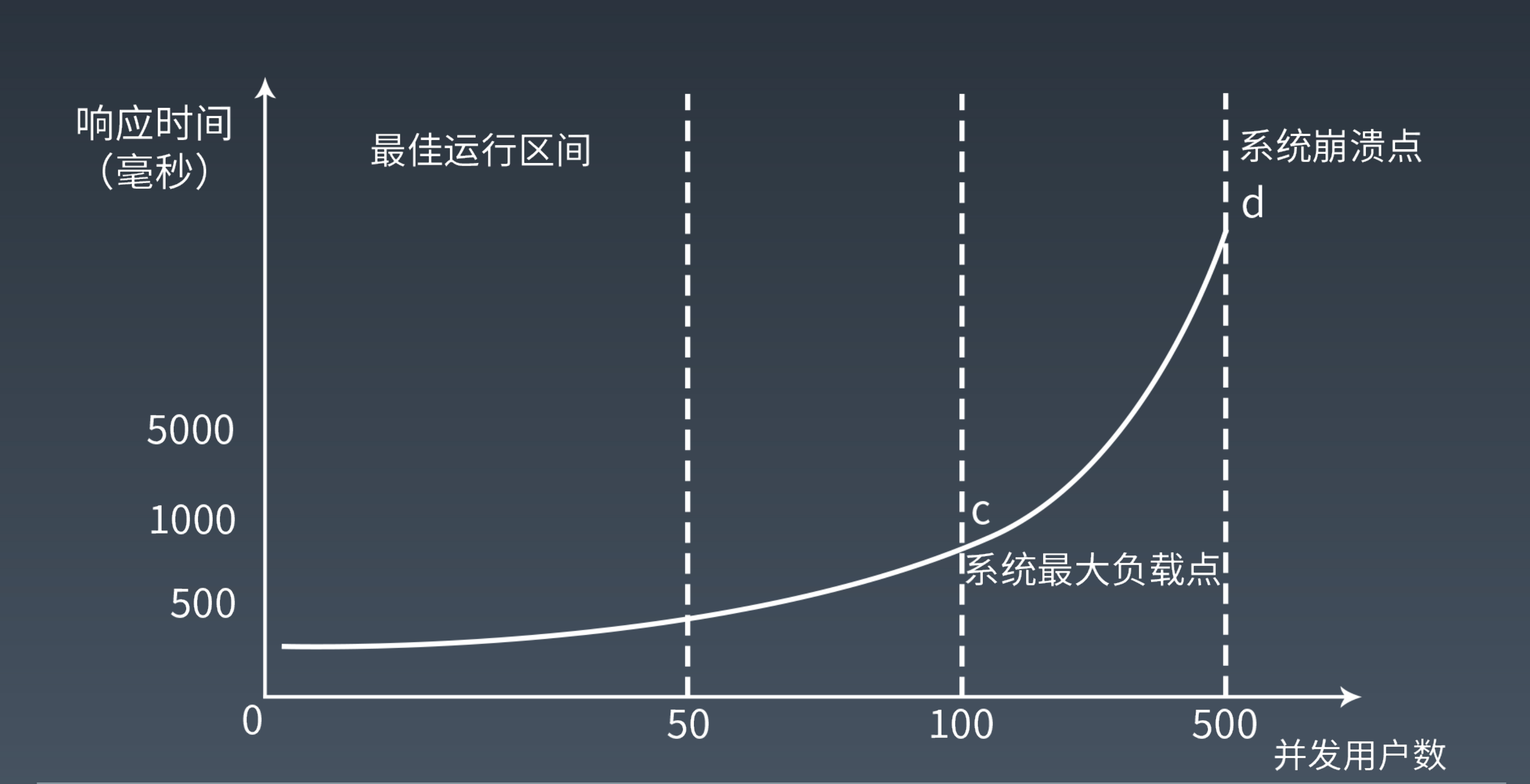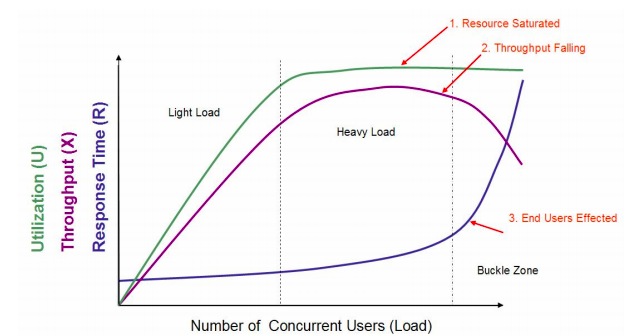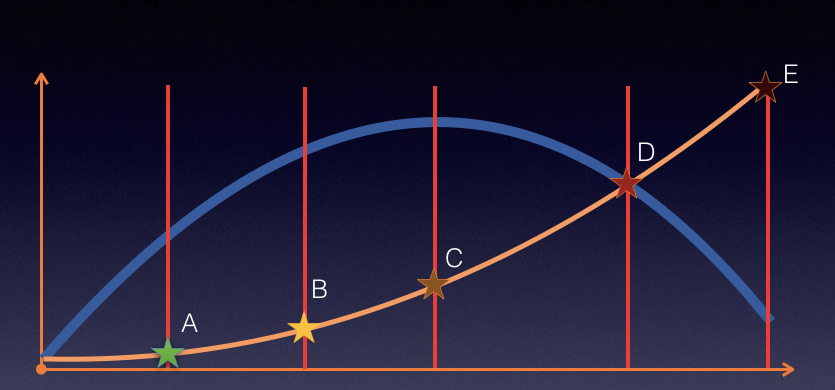性能压力测试的时候,随着并发压力的增大,系统响应时间和吞吐量如何变化,为什么


这是老师的ppt里提供的两个图。性能测试学习过程中,常见的图也包括下面这个
https://time.geekbang.org/column/article/178076

在这个图中,定义了三条曲线、三个区域、两个点以及三个状态描述。
三条曲线:吞吐量的曲线(紫色)、使用率 / 用户数曲线(绿色)、响应时间曲线(深蓝色)。
三个区域:轻负载区(Light Load)、重负载区(Heavy Load)、塌陷区(Buckle Zone)。
两个点:最优并发用户数(The Optimum Number of Concurrent Users)、最大并发用户数(The Maximum Number of Concurrent Users)。
三个状态描述:资源饱和(Resource Saturated)、吞吐下降(Throughput Falling)、用户受影响(End Users Effected)。
从图中可以看到,随着负载的增大,随着并发用户的增长,系统响应时间,吞吐率的变化。
当然,上图有一些不精确的地方,简化出另一个图形,以说明更直接一点的关系。如下所示:

在 TPS 增加的过程中,响应时间一开始会处在较低的状态,也就是在 A 点之前。接着响应时间开始有些增加,直到业务可以承受的时间点 B,这时 TPS 仍然有增长的空间。再接着增加压力,达到 C 点时,达到最大 TPS。我们再接着增加压力,响应时间接着增加,但 TPS 会有下降(请注意,这里并不是必然的,有些系统在队列上处理得很好,会保持稳定的 TPS,然后多出来的请求都被友好拒绝)。最后,响应时间过长,达到了超时的程度
压测程序
时间比较紧张,参考https://github.com/danielzhou/goablite
go routine http.Get(*u) 获取结果
/*
*/
package main
import (
"flag"
"fmt"
"net/http"
"os"
"runtime"
"sync"
"time"
)
// 参数
var (
n = flag.Int("n", 2, "Number of requests to run.")
c = flag.Int("c", 1, "Number of requests to run concurrently.\nTotal number of requests cannot be smaller than the concurrency level.")
p = flag.Int("p", runtime.GOMAXPROCS(-1), "Number of used cpu cores")
u = flag.String("u", "", "the url you want to connect.")
)
// 结果
var (
success = 0.0
failure = 0.0
useTime = 0.0
)
// 帮助信息
var usage = `Usage: hey [options...] <url>
Options:
-n Number of requests to run. Default is 20.
-c Number of requests to run concurrently. Total number of requests cannot
be smaller than the concurrency level. Default is 5.
-p Number of used cpu cores.(default for current machine is %d cores)
`
var wg sync.WaitGroup
// 主函数
func main() {
flag.Usage = func() {
fmt.Fprint(os.Stderr, fmt.Sprintf(usage, runtime.NumCPU()))
}
flag.Parse()
// 判断参数是否正常
if flag.NFlag() < 1 {
usageAndExit("")
}
runtime.GOMAXPROCS(*p)
num := *n
conc := *c
url := *u
if url == "" || len(url) == 0 {
usageAndExit("Please input the url you want to connect.")
}
if num <= 0 || conc <= 0 {
usageAndExit("-n and -c cannot be smaller than 1.")
}
if num < conc {
usageAndExit("-n cannot be less than -c.")
}
if *p > runtime.NumCPU() {
fmt.Printf("your computer have %d CPU cores\n", runtime.NumCPU())
usageAndExit("-p cannot bigger than that your computer have.")
}
startTime := time.Now().UnixNano()
// 并发开始
for i := 0; i < conc; i++ {
wg.Add(1)
go run(num / conc)
}
fmt.Println("主程序开始wait")
wg.Wait()
endTime := time.Now().UnixNano()
useTime = float64(endTime-startTime) / 1e9
// 输出结果
fmt.Println("Plan_Total:", *n)
fmt.Println("Concurrency Level:", *c)
fmt.Println("CPU Core:", *p)
fmt.Println()
fmt.Println("Complete requests:", success)
fmt.Println("Failed requests:", failure)
// fmt.Println("SuccessRate:", fmt.Sprintf("%.2f", ((success/total)*100.0)), "%")
fmt.Println("UseTime:", fmt.Sprintf("%.4f", useTime), "s")
fmt.Println("Requests per second:", fmt.Sprintf("%.4f", float64(*n)/useTime))
}
// 运行每个客户端
func run(num int) {
defer wg.Done()
no := 0.0
ok := 0.0
for i := 0; i < num; i++ {
resp, err := http.Get(*u)
if err != nil {
no += 1
continue
}
defer resp.Body.Close()
if resp.StatusCode != 200 {
no += 1
continue
}
ok += 1
continue
}
success += ok
failure += no
// total += float64(num)
}
// 提示信息
func usageAndExit(msg string) {
if msg != "" {
fmt.Fprintf(os.Stderr, msg)
fmt.Fprintf(os.Stderr, "\n\n")
}
flag.Usage()
fmt.Fprintf(os.Stderr, "\n")
os.Exit(1)
}
分别10并发和100并发,在100并发的时候部分返回结果错误,
100请求,10并发
Plan_Total: 100
Concurrency Level: 10
CPU Core: 4
Complete requests: 100
Failed requests: 0
UseTime: 31.7410 s
Requests per second: 3.1505
Exiting.
Debugger finished with exit code 0
200请求,100并发:
主程序开始wait
Plan_Total: 200
Concurrency Level: 100
CPU Core: 4
Complete requests: 185
Failed requests: 15
UseTime: 283.5817 s
Requests per second: 0.7053
Exiting.
Debugger finished with exit code 0
补一个java版本的
package com.zhk.metricscollections.request;
import lombok.Data;
/**
* @author zhuhk
* @create 2020-07-23 9:49 上午
* @Version 1.0
**/
@Data
public class RequestInfo {
private String apiName; // 扩展
private double responseTime; //扩展
private long timestamp;
}package com.zhk.metricscollections.service;
import com.zhk.metricscollections.request.RequestInfo;
import java.io.IOException;
import org.apache.http.HttpEntity;
import org.apache.http.HttpResponse;
import org.apache.http.client.ClientProtocolException;
import org.apache.http.client.ResponseHandler;
import org.apache.http.client.methods.HttpGet;
import org.apache.http.impl.client.CloseableHttpClient;
import org.apache.http.impl.client.HttpClients;
import org.apache.http.util.EntityUtils;
/**
* @author zhuhk
* @create 2020-07-23 11:05 下午
* @Version 1.0
**/
public class HttpHandler {
public static RequestInfo doGet(String url) throws IOException {
RequestInfo requestInfo = new RequestInfo();
long start = System.currentTimeMillis();
CloseableHttpClient httpclient = HttpClients.createDefault();
try {
HttpGet httpget = new HttpGet(url);
System.out.println("Executing request " + httpget.getRequestLine());
// Create a custom response handler
ResponseHandler<String> responseHandler = new ResponseHandler<String>() {
@Override
public String handleResponse(
final HttpResponse response) throws ClientProtocolException, IOException {
int status = response.getStatusLine().getStatusCode();
if (status >= 200 && status < 300) {
HttpEntity entity = response.getEntity();
return entity != null ? EntityUtils.toString(entity) : null;
} else {
throw new ClientProtocolException("Unexpected response status: " + status);
}
}
};
String responseBody = httpclient.execute(httpget, responseHandler);
requestInfo.setTimestamp(System.currentTimeMillis() - start);
// System.out.println("----------------------------------------");
// System.out.println(responseBody);
} catch (ClientProtocolException e) {
e.printStackTrace();
} catch (IOException e) {
e.printStackTrace();
} finally {
httpclient.close();
}
return requestInfo;
}
}
package com.zhk.metricscollections.service;
import com.zhk.metricscollections.request.RequestInfo;
import java.io.IOException;
import java.util.ArrayList;
import java.util.List;
import java.util.Optional;
import java.util.concurrent.LinkedBlockingQueue;
import java.util.concurrent.ThreadPoolExecutor;
import java.util.concurrent.TimeUnit;
import java.util.stream.Collectors;
import java.util.stream.IntStream;
/**
* @author zhuhk
* @create 2020-07-24 7:29 上午
* @Version 1.0
**/
public class PressCreater {
private int n = 1;
private int c = 1;
private String url;
public PressCreater(int n, int c, String url) {
this.n = n;
this.c = c;
this.url = url;
}
public List<RequestInfo> doPress() throws InterruptedException {
List<RequestInfo> respList = new ArrayList<>();
ThreadPoolExecutor executor = new ThreadPoolExecutor(c, c,
0L, TimeUnit.MILLISECONDS,
new LinkedBlockingQueue<Runnable>());
IntStream.range(1,n).forEach(i -> {
executor.execute(() -> {
RequestInfo resp = null;
try {
resp = HttpHandler.doGet(this.url);
} catch (IOException e) {
e.printStackTrace();
}
respList.add(resp);
});
});
while (executor.getActiveCount() > 0) {
Thread.sleep(100);
}
executor.shutdown();
return respList;
}
public long getAvgRespTime(List<RequestInfo> respList) {
return Optional.ofNullable(respList).orElse(new ArrayList<>()).stream()
.map(RequestInfo::getTimestamp)
.collect(Collectors.averagingLong(Long::longValue)).longValue();
}
public long getAvgRespTime(List<RequestInfo> respList, int percent) {
long avgRespTime = 0L;
Optional<List<RequestInfo>> respTimesOptional = Optional.ofNullable(respList);
if (respTimesOptional.isPresent()) {
avgRespTime = respTimesOptional.get().stream()
.map(RequestInfo::getTimestamp)
.sorted()
.collect(Collectors.toList())
.get(Math.max(Math.floorDiv(respList.size() * percent, 100) - 1, 0));
}
return avgRespTime;
}
public void print(List<RequestInfo> respList) {
System.out.println(String.format("并发 %d 访问 %s,总计访问 %d 次,压测结果:", this.c, this.url, this.n));
System.out.println(String.format("平均响应时间: %d ms", this.getAvgRespTime(respList)));
System.out.println(String.format("95%s响应时间: %d ms", "%", this.getAvgRespTime(respList, 95)));
}
}
package com.zhk.metricscollections.service;
import com.zhk.metricscollections.request.RequestInfo;
import org.junit.jupiter.api.Test;
import java.util.List;
class PressCreaterTest {
@Test
public void testPressCeater() throws InterruptedException {
String url = "http://www.baidu.com";
int c = 10;
int n = 100;
PressCreater pressCreater = new PressCreater(n, c, url);
List<RequestInfo> respList = pressCreater.doPress();
pressCreater.print(respList);
}
}并发 10 访问 http://www.baidu.com,总计访问 100 次,压测结果:
平均响应时间: 1462 ms
95%响应时间: 7657 ms